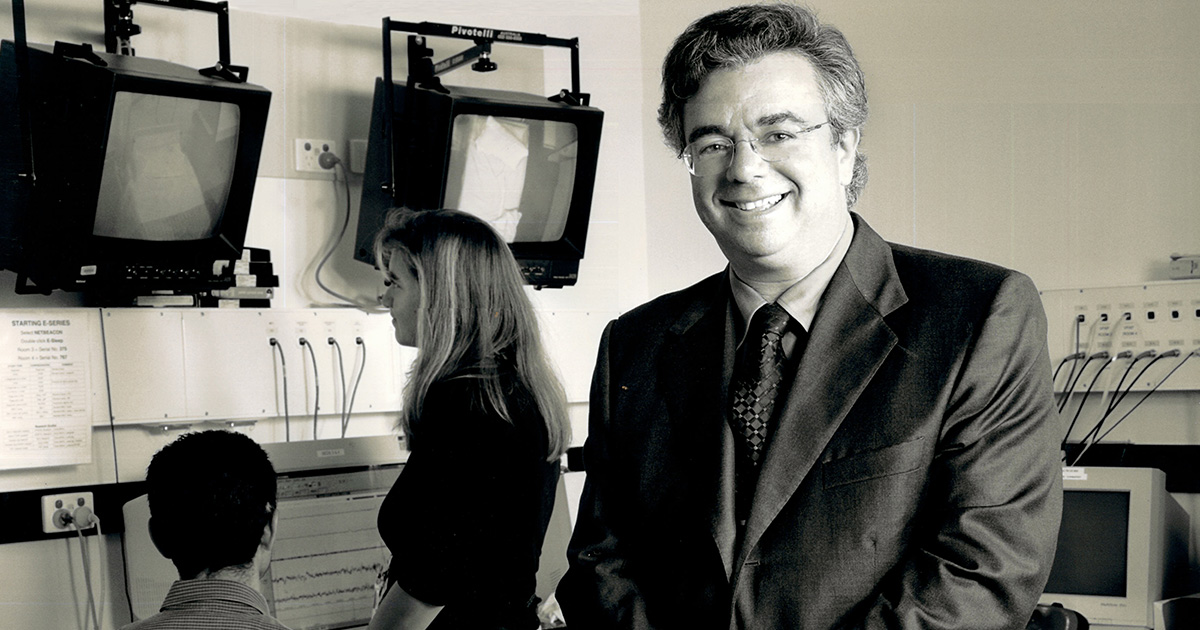The Woolcock Institute of Medical Research

Clinic key to sleep success
As we prepare to move to our new home alongside Macquarie University, we look at what we’ve achieved at Glebe in a series of four interviews with Woolcock researchers.
During our 16 years at Glebe, the Woolcock’s Sleep and Circadian Research group has grown more than five-fold into a multidisciplinary team with clinical, research and data science expertise.
Research Leader Professor Ron Grunstein says the move to Glebe in 2007 allowed the group to plan for growth. At the time they had 15 members, there was redundant space at the new location and a Clinic which from the outset had 14 beds for sleep studies.
Capacity in the Clinic
“Before Glebe, we used the Royal Prince Alfred Hospital sleep lab for research where we had only five beds so we couldn’t do a lot of the work that we do now. At the new clinic, we didn’t fill the 14 beds straight away. Realistically it built up over time as people got to know we were here and what we could do but within the first year, it was already pretty busy.”
He believes having that sort of capacity in the Clinic is still a big advantage. “We’re just finishing a narcolepsy study with a US sponsor – 10 days for each patient, housed here and lots of screening and additional tests. There’s nowhere else in Australia that can do that, there are probably only half a dozen places in the world that could.”
The opportunities the new dedicated clinic at Glebe offered to researchers were also important to the group’s growth. They’d previously worked with clinicians from the hospital and a private medical centre nearby, sometimes collaborating with ENT specialists or a psychiatrist, but only on an ad-hoc and pretty basic level.
A Multidisciplinary Approach
“In the middle of 2005, the Institute of Medicine in the US came out with a statement saying that sleep needed to be a multidisciplinary field to grow. We took that on board and when we’d made the move we were able to get people from diverse areas involved – dentists, ENT surgeons, neurologists, psychiatrists and psychologists. The Clinic also allowed us to attract younger doctors who could be involved in research and clinical trials one or two days a week and maintain a clinical practice.”
“These facilities have also given rise to access to amazing equipment. It builds upon itself – you build the facilities, you create the team, you do good research, then you can apply for funding for equipment through government or philanthropy. And having equipment like high-density EEG means you can expand your research into new areas.”
The Sleep and Circadian Research team now includes people with a wide range of skills – from clinicians who identify medical conditions and what the problems are for both patients and doctors, researchers who collect the data and data scientists who analyse and interpret it – all working together to try and solve the problem. That translation from bedside to bench and back is key to research in all groups at the Woolcock.
Want to stay up to date with our research on sleep and respiratory conditions?
Sign up to our monthly newsletter
New Avenues for Growth
Professor Grunstein believes the move to Glebe and working together in the one space also meant they worked more effectively.
“Before Glebe, we had anything up to eight different locations for people who had something to do with the Sleep group. We didn’t have a meeting space, so it was difficult getting people together. We did it, but it was hard work. Here, we have that and the informal interactions that come from being in the same space which meant, suddenly, we were sorting things out more quickly.”
He believes the move to Macquarie offers a host of new opportunities in sleep. “Space is no longer as important. COVID restrictions taught us that people can be productive at home and that means hot desking will be routine. We won’t need more space, but we can work smarter. Macquarie University is a big campus, with lots of students in psychology, neurobiology and other fields, which is very supportive of health research and that alignment means we can explore new avenues as we become more integrated with them over time.”










